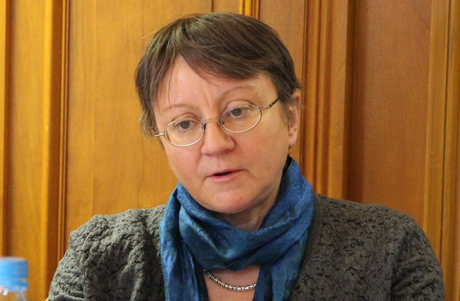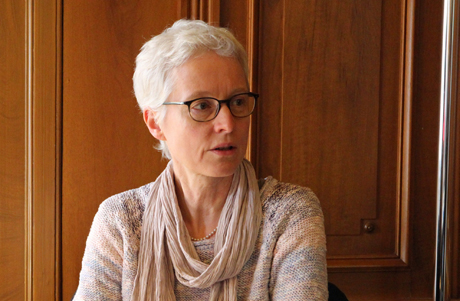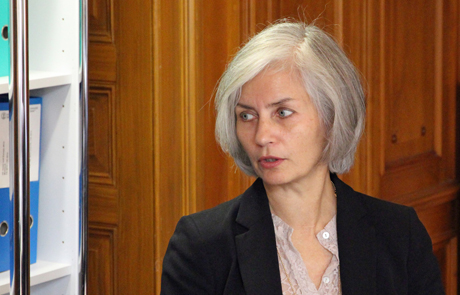Navigation auf uzh.ch
Navigation auf uzh.ch
Organizing the 2016 annual conference under the title “Human : Non-Human—Bodies, Things, and Matter across Asia and Europe” (October 6–8, 2016), Bettina Dennerlein, Professor of Islamic and Gender Studies, Angelika Malinar, Professor of Indian Studies, and Andrea Riemenschnitter, Professor of Chinese Studies, discuss their interest in the conference’s topic.
Interview: Roman Benz
The annual conference will deal with the ways in which cultural representations and social practices are based on how distinctions between bodies and things, humans and non-humans are conceptualized. In which theoretical traditions are such distinctions discussed?
Angelika Malinar: The spectrum of theoretical approaches and traditional discourse—Asian as well as European—is quite large. In the last few decades, well-established key terms such as “nature” were put into question and new theoretical frameworks were proposed, such as “new materialism” or “object-oriented ontology.” Within these frameworks, the concept of matter plays a key role in querying classical distinctions between body and mind, humans and non-humans, or subject and object. For instance, object-oriented ontology emphasizes the agency of what is deemed a thing or “object” being at the disposal of “subjects” and explores the modeling of “subjects” by their handling of objects. Such approaches are intrinsically connected to debates on postmodernism and post-humanism, which are in turn intertwined with the criticism of colonial-modern regimes of power in postcolonial theory. The current theoretical concerns are thus intertwined with histories of colonialism, environmental destruction, and the exploitative structures that have unfolded in modernity and at present in the so-called globalized capitalism.

Bettina Dennerlein: I think that the field of Gender Studies, for example, is already heavily involved in questioning such boundaries, especially with regard to body and corporeality. They have since long started to criticize simplistic distinctions, like the one between gender identity as socially constructed and sex as an anatomically fixed phenomenon that is to be taken as a “natural” given. Yet generally speaking, the conference is less dedicated to a particular set of theories than to pursuing questions that have been asked more recently as a consequence of different theoretical “turns” like the somatic turn, the material turn and, last but not least, the post-humanist turn. It is also about rethinking the categories that we use and the historical and normative baggage they carry with them. From this perspective, we have chosen to focus more particularly on entanglements between Asia and Europe, looking at how bodies, things, and matter are defined and positioned in relation to each other on different levels and in different respects. We are interested in how concepts and constituted systems of knowledge as well as normative orders configure, impose, and at the same time “naturalize” boundaries between human and non-human, bodies and matter, matter and things. Such boundaries are actually highly contingent and subject to change over time. We suggest exploring the shifting contours, fissures and ambivalence of conceptual, scientific and normative schemes beyond a particular theoretical or political program.

Andrea Riemenschnitter: In the context of the conference, another perspective is interesting, namely how new disciplines come into being. An example would be the so-called environmental humanities, which developed in close interaction with the natural sciences. For a long time, the humanities were most interested in asserting their own disciplinary identities vis-à-vis the dominance of a science-based worldview and its exclusion of methodological tools from the humanities. By now, the dialogue between humanistic and scientific paradigms has become a mutual pursuit. Moreover the growing impact of environmental issues such as climate change intensifies academic interest in a multidisciplinary, integrative approach to matter. In the wake of these challenges, all academic disciplines move away from the question of human sovereignty, studying questions of entangled human-nonhuman agencies in planetary ecologies, and thereby embrace the concept of an open relationship between human beings and other forms of matter.

Malinar: I think that the current theoretical attempts to reconfigure relationships between human and non-human is a challenge that will stay with us in the future and which will even intensify due to the changes that have already taken place. At the level of practice, the familiar ideas are often already disposed of. The technical possibilities more and more determine the scope of practice. Already today, we have the practical experience of how the old boundaries between body and thing dissolve, because the boundaries that used to define bodies are reconstructed due to the instruments made accessible by bio-technological, digital and other developments.
Is this shifting of boundaries between what is alive and what is not alive something that happens in practice, or is it due to a new perspective?
Dennerlein: I would say that shifts take place on both levels. There are important changes happening, for example, in the fields of bio-engineering and life sciences, but it takes time for the consequences of these changes to be perceived and understood not only by a broader public, but also in the humanities and the social sciences. Look, for instance, at metaphors of organicism and related ideological stances especially with a view to gender and sexuality. While clearly no longer corresponding to scientific interpretations of the human body, organicist “truths” (or rather truisms) do not seem to lose in currency. Donna Haraway has argued long ago, that the biomedical understanding of the human body as an information-processing system may open up new avenues for critiquing positions that ground sexual difference in the fixed anatomy of the organic body. These avenues still need to be further explored.
Riemenschnitter: In my opinion, the recent advances in bio-engineering and other matter technologies are not the only reason for our perspectival shift towards nonhuman agency. In many Asian countries, we observe a return to traditions with a different approach to the relationship between human beings and things. In China, humans were in fact counted into the crowd of the world’s ten thousand things as simply one variety among them. In a modern Chinese poem from the 2000s, a painting from the eleventh century is praised for not privileging human subjectivity. When I read that a particular tree’s self-cultivation is depicted as superior to the degree of self-cultivation reached by the people in the painting, I get the impression that the authority of artificial boundaries between body and matter as postulated in the West is finally questioned by non-Western intellectuals who until recently had no choice but to follow the hegemony of global scientific discourse. It has become obvious that these boundaries have been of limited use, considering the fact that we are now destroying what had helped us to advance our civilization and culture.
Dennerlein: I would like to add only parenthetically that the so-called Western perspective is probably in itself less stable and more ambivalent than we might think. Bruno Latour has shown from a history of science perspective that the boundary between the “natural” and the “social” has indeed never been impermeable.
Malinar: Regarding the conference, we want to explore whether there are other ways to envision relationships among humans as well as between humans and non-humans—differing from the hegemonic forms of practice that became dominant due to colonial-modern economic systems, exploitation techniques, and related discourses of justification. There are some attempts to go back to traditions. For instance, Western philosophers and intellectuals currently rediscover earlier thinkers as sources for alternative concepts of body and matter, in particular Spinoza and Aristotle. Also the Indian intellectual and religious traditions are reconsidered for concepts and practices that defy anthropocentrism, such as ideas of ritual ecology.
However, one must not forget that these traditional, alternative conceptualizations are connected to certain regimes of power and oppression as well—slavery, for instance. Thus, it could happen that in the name of a return to so-called traditional forms of practice, suppressive techniques are continued that existed already in this tradition. There are many deplorable examples for these processes.
So, the recourse to traditions is not always successful?
Malinar: It does not automatically mean a questioning of the power constellations that support forms of practice we usually call capitalism, modernity, and so on. For example, in the region in India where I have conducted research for some years, there was a recurrent discussion about impoverished tribal groups, who have no other choice than to eat ground mango kernels. The discussion about the situation of these groups includes arguments about how healthy or traditionally accepted these mango kernels are and so on. Wrapped in the guise of traditionalism, this modern constellation of exploitation and poverty—which itself continues earlier forms of the same—is legitimized.
Riemenschnitter: Indeed, it is not clear whether this new interest in traditions involves rescue from precarious living conditions. Take the example of aid projects with a background in traditional discourses, such as the effort of international NGOs to protect Bengal tigers in the Sundarbans. For this aim, displaced people looking for a new home in the Sundarbans are forced to move on. Although the protection of the tigers is directed against the colonialist and capitalist assaults on so-called non-productive livelihoods, the project involuntarily supports the suppression of local people—in the name of seemingly respectable reasons. Therefore, a look at matter as an actant in Latour’s understanding may be helpful, since it enables us to unmask shortsighted ethical dogma.
Dennerlein: We are obviously not intending to change the course of global capitalism, but rather to think about possibilities for critique that emerge from within the ruptures and fissures of globalization between Asia and Europe. Starting from different experiences of globalization, we intend to look at the contingencies—not to mention the constructed status—of existing schemes of classification and their effects, as well as look at different forms of resilience, displacement and subversion. Crossing disciplinary and regional perspectives may help here to contextualize the phenomena we study without reifying “context.”
At what stage is the discussion of “human” and “non-human?” Is it in the stage of making inventory or do serious approaches to solutions exist for, say, the impending environmental destruction?
Riemenschnitter: If you grapple mainly with cultural or literary texts, you can see that a lot has changed already. For example, a contemporary Chinese poem describes a visit to a classical scholar’s garden. This traditionally is a place where boundaries between the human subject and the surrounding substance are intentionally blurred, a place of contemplation where certain plants, rocks, and ornaments should be arranged in a given order so as to create an environment that helps the visitor withdraw from the mundane world and reach a state of transcendence. In this poem, no subjective experience is described, but readers are made to watch what is happening today in this garden: Led by their guides, hordes of tourists fill it, looking for thrills, making noise and taking selfies. It becomes obvious that there is something fundamentally wrong with the current exploitation of such gardens by mass tourism, and that there are no benefits to speak of either for the garden or for the visitors. Actually, it is beneficial only for the accumulation of capital, which is abstract and has no relevance in matter-based cycles of improvement.
On the other hand, there are signs of hope. At the micro level, you can observe serious efforts to find solutions. Communities are formed that withdraw from the dominant system as far as possible and aim to live self-sufficiently. Some artists’ villages in Asia retreated to the countryside, laid out gardens and grew their own food. Their inhabitants try to define themselves as part of, and in an organic relationship with, matter insofar as they no longer understand humans to be the singular subjects and ultimate targets of civilizational progress.
(Asia & Europe Bulletin, 5/2016, pp. 7–9)